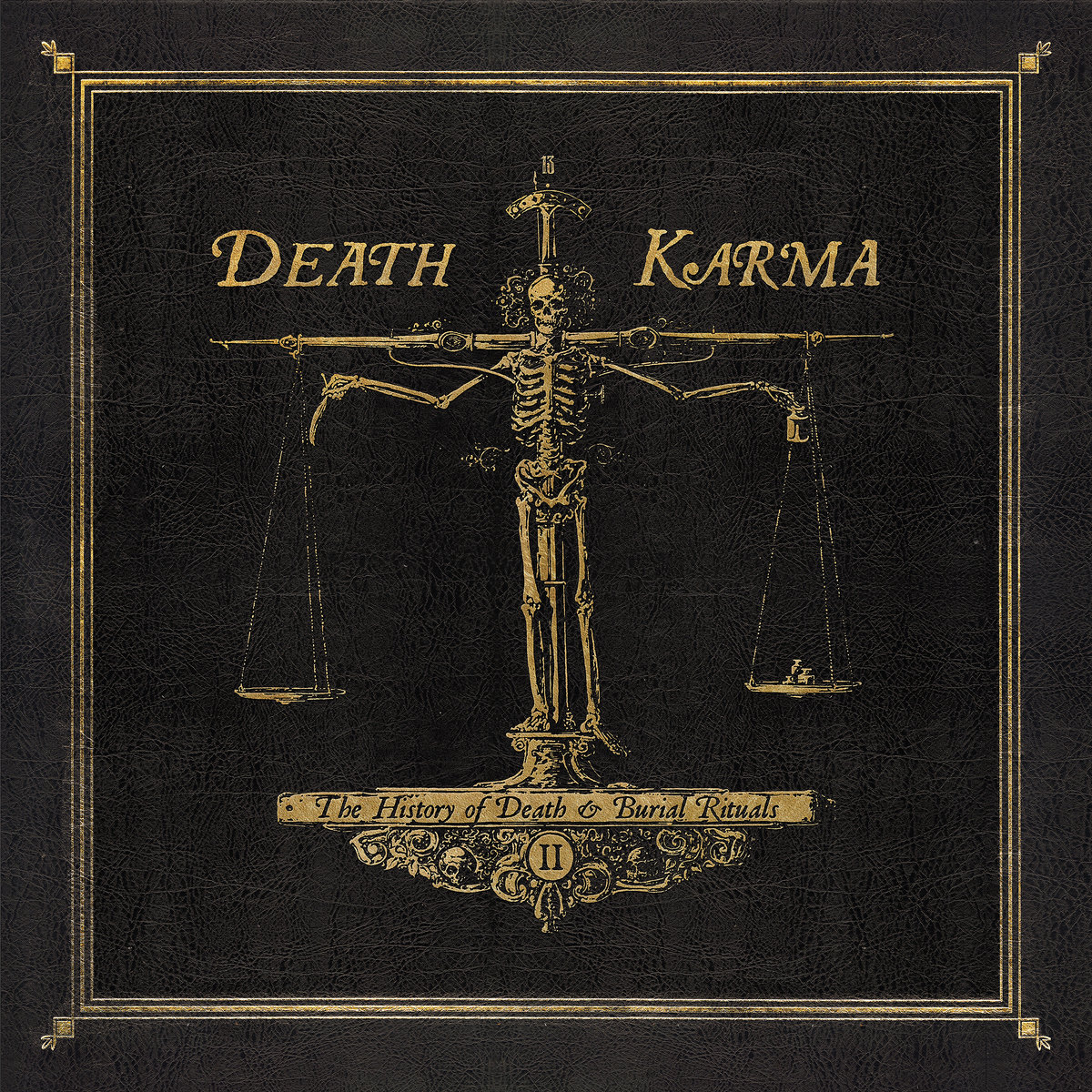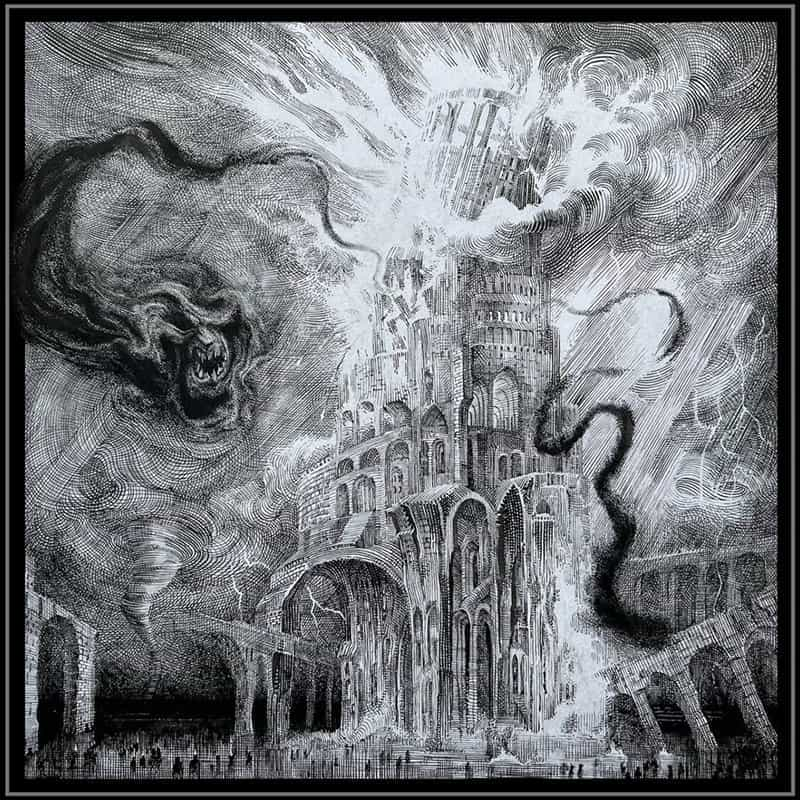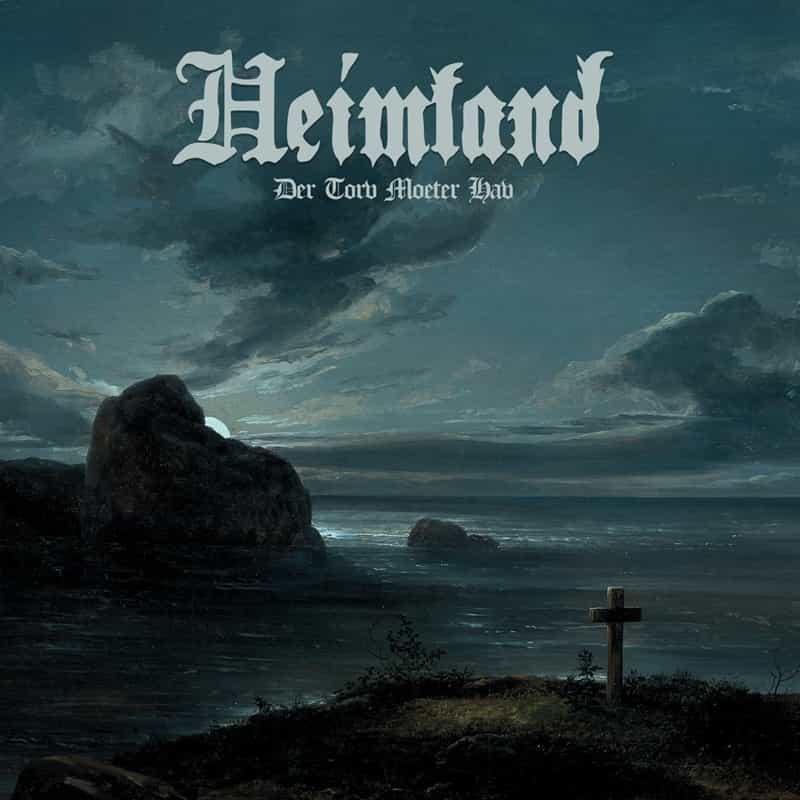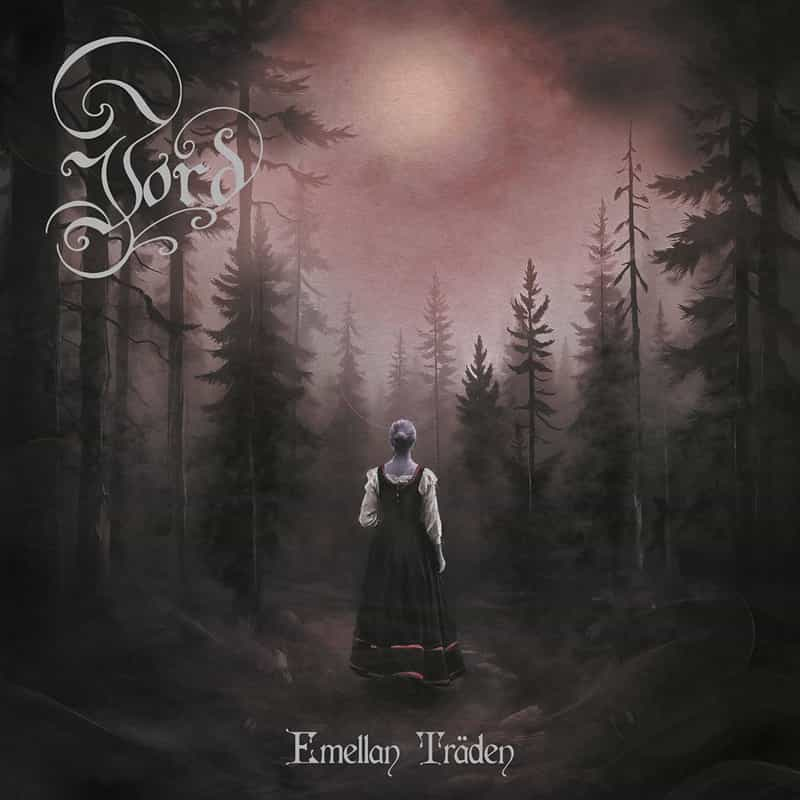Death Karma: Review + Exclusive Words by Infernal Vlad

Band: Death Karma
Title: The History of Death & Burial Rituals Pt II
Label: Beyond Eyes Productions
Release date: 24 November 2018
Country: Slovakia
Format reviewed: Digital stream
“For those who seek to understand it, death is a highly creative force,” wrote the psychiatrist Elisabeth Kübler-Ross. “The highest spiritual values of life can originate from the thought and study of death.” Don’t we just know it? Metal’s territories may be vast but the most interesting ones are cthonic – pertaining to the things ov the underworld. Your mortuary meditation of choice may depend on the sub-genre: modern black metal, like doom, often concerns itself with philosophical or demi-spiritual reflections on grief, loss, annihilation and transformation, whereas death metal has always had a preoccupation with the physical trappings: the causes of demise, the disposal of bodies, the ultimate fate of the deceased. Depending on your mood, you can go high-brow with particularly poignant recent soundscapes from bands like HAMFERÐ and ALTARS OF GRIEF, which tell desperate, human stories of mourning. Or, if you like, you can dip your toes in the never-ending supply of snuff metal, which I guess is not without its own peculiar charm (that PISSGRAVE cover, tho…). Then you’ve got my own true love, blackened death, that glorious behemoth (small ‘b’) straddling the two, its stomping ground being wherever the hell it likes, making room for all sorts of creative possibilities and drawing from a multitude of thematic, musical and cultural influences.
Levitating somewhere above this venn diagram, Vladimír Pavelka (‘Infernal Vlad’) pours out his libations for the second time on his DEATH KARMA project’s ‘The History of Death and Burial Rituals Part II.’ Appreciators of his work with acclaimed Vedic black metal trio CULT OF FIRE will recognise his signature dedication to the minutiae; but whereas CULT OF FIRE focuses on the Hindu religion, here Vlad broadens his mystical vision. As with 2015’s ‘Part I,‘ the listener is initiated into the funerary customs of a handful of diverse peoples, this time ranging from a sky burial in Tibet to a Mighty Mongrel Mob cortege in New Zealand. Vlad is joined by CULT OF FIRE associate Tom Coroner on drums, with lyrical anthropology from Czech horror writer Jan Pavlas. If none of this sounds exciting to you, then I suspect that you, O reader, are also dead.
I contacted Vlad shortly after ‘Part II’ was released. Whether he’s playing his ornate brand of black metal with CULT OF FIRE or switching it up with some absolutely almighty old-school riffing as he does with DEATH KARMA, Vlad has a singular talent for being able to conjure deities, spirits and ancient memories, and I was curious about the experiences that had provided him with such a formation. Not one for giving interviews, he suggested writing some words instead. I was genuinely surprised when I received the piece back in December. If you expected this album to be the product of some backpacking gap-year hipster trip, think again: it is rooted in real, practical experience with the dying and the dead in a hospital setting, but also in places eerily manages to call to mind scenes from the Danish thriller ‘Nattevagten’ (‘Nightwatch’). Vlad’s words are translated and reproduced in full underneath this review.
The rattling of a calabash signifies the beginning of our thanatological tourist trip: first stop, Haiti. The bright opening strains, with tribal accompaniment from Czech percussionist TOKHI (which underpins the whole experience) immediately show us that these compositions are going to get the dynamic production treatment they deserve, which is a relief because Vlad’s writing skills are tighter than ever. Musically, the track vividly conveys the kind of animalian frenzy you’d expect from a voodoo ritual, with lyrical references to rooster sacrifice and the charismatic rum-swilling, cigar-smoking loa (spirit) of the dead, Baron Samedi. New melodies weave in and out, never departing too far from that simple but huge central riff, and then pile on top of each other, giving way at a few intervals to a low, gurgling incantation. There is a real feeling of something being awakened and then accomplished. ‘The spirit has been satiated’ indeed: this is exuberant occult black/death at its finest. It’s a fuckin’ banger with infectious grooves that remind me of peak ARALLU, MELECHESH or the recent AKHENATEN.

And so it continues. If in Haiti Vlad was a houngan (voodoo priest), he switches his robes effortlessly to become a Tibetan monk on the second track, where we witness the ‘macabre theatre’ of a sky burial – the practice of ‘disassembling’ a body and then leaving it to the elements for the consumption of carrion birds (hence ‘sky’ burial). The intro sets the scene vividly, evoking a feeling of standing up there on the Tibetan plateau, griffon vultures circling above, as the ‘body-breakers’ hack the limbs off the corpses and encourage the birds to descend and feed – a final act of charity on the part of the deceased, to provide food for the living. Fearsome riffing then flies in, replicating the frantic pecking of beaks at exposed sinew, before all goes quiet and the six syllable mantra is chanted. There are many moments on this album that make you want to sit back and let the warm flood of appreciation wash over you, and one of them is when the beat comes back in under the deep repetitions of om mani padme hum, ushered in by the crashing of a gong. The blueprint is laid down for the remaining tracks: the cinematic intro, the ascent to the summit, the final climactic finish (you’ve got to check out a truly enormous moment on ‘Scandinavia – Ship Burial’), and this is done to such satisfying effect on every track that literally any of them could be the grand finale.
This includes the punchy ‘New Zealand – Mongrel Mob’, which may look incongruous on paper, with the Mob dating only back to the 60s, but in practice fits perfectly with the project’s mission. After all, a number of the customs described elsewhere on the record are still practiced: while ‘Egypt – Pharaohs’ is a window into the past (and it still amazes me that a vehicle as modern as metal is able to do this), the Tana Torajans of Indonesia – portrayed on one of the album’s most sophisticated tracks – continue to mummify their deceased, and even live with them for what can sometimes be an extended period before burial. Whilst still possessing baroque moments, it is largely an attack of blackened death/thrash that in places reminds me of THE CROWN, its ‘traditional’ instrumentation being the Mob’s trademark howl and the revving of motorcycle engines that can be heard both on the intro and on a clever pace change that feels like a ride on a long stretch of road. I had to do a bit of digging into what the Mob’s ‘funeral rite’ might be, but it seems to be the use (or misuse, as some New Zealanders apparently feel) of the Maori tangi.

In the process of writing this review, I’ve become conscious that I may unwittingly have given the impression that ‘Part II’ is just a culture-appropriating pastiche by pointing out everything that is ‘ethnic’ about it, but this isn’t a random hodge-podge of regional instruments thrown together to create some kind of disjointed world music compilation. The inclusion of tasteful amounts of these elements helps to locate us, yes, but even without them I would probably be able to tell roughly what each song was driving at, and that’s thanks to Vlad’s writing skills and those huge, melodic leads. In any case, if you do want to embrace the experience, and if you’re into the old-school art of liner note forensics, there’s plenty to dig into here: the lyrics are accompanied, not only by fantastically detailed pictures drawn by artist Dávid Glomba, any of which I’d be happy to hang on my wall, but also with a bibliography referencing books and videos. It is, if you want it to be, an immersive experience on multiple levels, and another advantage of buying a physical copy is that you also get an extra track, an atmospheric instrumental based around Japan’s suicide forest.
I can’t help but pick up a note of awe and humility, and it’s refreshing in this scene. Vlad quietly (and dare I say fondly) attends to the world’s cadavers on their own cultural terms, which is quite touching. In the same way that the Tibetan sky burial is said to be the ultimate act of compassion, I believe that what Vlad has created here is a colourful, living tapestry that honours the ways we mortals process grief, the ‘whirling gyre,’ as Nick Cave recently said, within which ‘all manner of madnesses exist.’ I don’t know if a ‘Part III’ is planned, but the DEATH KARMA project will never be at a loss for material as long as it continues to mine the richness of the human experience for inspiration. This is the ‘real’ death metal, and long may it live. 9.5/10. The Grim Princess
Infernal Vlad: On the Origins of his Fascination with Death
The first touch of death I experienced in the first second of my life, at birth, when I was born with the umbilical cord wrapped twice around my neck, like a noose. They told me I was completely blue; or maybe it was because the blue goddess of death, Kali, stood by me…
The second deep touch of death occurred when my grandfather died unexpectedly. He was an extremely important person in my life, from whom I draw today. This wound has not yet been healed, and will be the subject of a fully-fledged solo album in the near future.
The third touch shapes me to this day and I am what I am because of it. It started eighteen years ago. I was working in the hospice department in the hospital in the town I come from. Since there were mostly elderly patients and patients after severe surgery, the mortality rate was high. According to my statistics, death came to take its toll every fourth day, and most of the patients died in room number seven. It was here I encountered my first exitus: a 130kg gypsy woman. I weighed at that time about 65kg, so to carry her out of the room to the morgue was incredibly challenging. The work there was at once beautiful and terrible; sometimes still, sometimes totally chaotic. But it was the greatest school of death I had received.
My work involved a lot of activities, such as helping with morning hygiene, feeding, carrying samples to the laboratory, and spending time with the patients. With astonishment I listened to their narratives – beautiful memories and sad stories – or just sat beside them in a half-empty room with one bed on which the patient lay, already oblivious to this material world. The body doesn’t want to give up easily. It tries to breathe as hard as it can, gasping. I sat waiting for the final breath that would announce the time of exitus. I sometimes still hear that gasping sound now.

After the last exhalation, the whole body and muscles are relaxed and usually some bodily fluids are exuded. It was my duty to wash the body thoroughly afterwards, so one could fully see the anatomy of the person. But it never occurred to me that the dead body was disgusting. Each body has its life story written on itself, and if you really want to, you can read it there. After washing, the patient’s name and year of birth is written with potassium permanganate on the body and they are then wrapped in clean sheets, like a mummy. Two hours later the ‘black ambulance’ is called to transfer the cadaver to the hospital morgue. I remember once, there was a very heavy snowfall and the van couldn’t drive up the hill to the building where our department was. So I took the mummy in my arms and as half-dead lovers we walked through the deep snow to the morgue, which was about 300 meters away. The nurses hysterically screamed at me from the window that I was mad, but I replied that the rules were the rules and that after two hours the body has to be taken away to the morgue, regardless. Of course, I made a copy of the morgue’s key and spent almost every evening and weekend there, in the company of my closest in life, paradoxically, the dead. What I experienced behind the locked doors and gridded windows, I keep to myself.
So death is, for me, my life’s love, inspiration, terror and teacher, as well as my path through this life. That is why I want to make death more familiar to people all around the world through my music: so that the traditions, rituals, the perception of death itself, the different techniques of burial, and the history of death, will not be forgotten.
“Death is a wiser teacher than life.”
Vladimír Pavelka
Anno Domini 2018

With heartfelt thanks to Vladimír Pavelka. Vlad’s words were kindly translated for Blessed Altar Zine by Standa Sanour Novotný, and adapted by The Grim Princess. Photos courtesy of Vlad.
Quotation from Elisabeth Kübler-Ross taken from ‘Death: The Final Stage of Growth’ (Simon & Schuster/Touchstone, 1974). Nick Cave’s words were taken from The Red Hand Files, Issue #6, October 2018.
Label
Bandcamp
Facebook
Website
9.5/10 Epic Storm
**Please support the underground! It’s vital to the future of our genre.
#WeAreBlessedAltarZine
#TheZineSupportingTheUnderground


